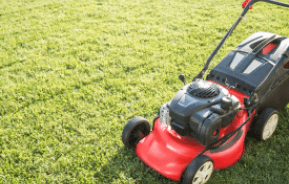
Grow Big or Go Home: Fertilising Fundamentals
So just what is the perfect lawn? It’s one of those questions that will likely conjure up different images for different people – a secluded little corner to just stretch out and chill, maybe the dead-flat, tightly-trimmed bowling green look, or for you is it a romantic, meandering pathway of emerald green? Regardless of the shape, size or form of your dream lawn there is undoubtedly one part of the picture that remains consistent: lush grass underfoot.
Sadly, this often isn’t the way our lawns are. They take quite a beating, from everything the weather throws at them, to kids and dogs and occasionally serving as a carpark and, let’s face it, neglect. It’s little wonder they can look tired and thin or patchy.
Thankfully there is one seriously simple and easy way to give your lawn the opportunity to look its best - regular feeding with a quality lawn fertiliser. Studies have shown that as few as one in four homeowners feeds their lawn. This is despite it being so easy, so budget-friendly and such an effective way to improve the health, vigour and appearance of your lawn.
The benefits of fertilising your lawn
There’s a very old saying – an ounce of prevention is better than a pound of cure – and nothing could be more spot-on when it comes to feeding your lawn.
There are the obvious advantages to a well-fed lawn, such as lush green growth and feeling great underfoot, but there are a few things you might not think about that come as an added bonus with a garden of healthy grass.
Fights weeds
Most lawn weeds are known to horticulturalists as ‘adventitious colonisers’. Basically, these weeds see a gap and they jump in to fill it. If your lawn is not performing well, it can become sparse, creating the perfect environment for these weeds to take hold. A strong, full lawn will not give weeds the opportunity to establish and if any weed seeds do germinate the grass will often out-compete them.
Copes better with climate extremes
Lawn Builder fertilisers contain the right balance of nutrients to build a strong, healthy lawn. The nitrogen gets those leaves growing well. Potassium helps the lawn take up the nitrogen and, importantly, it builds stronger cells. When your lawn has quality growth support by robust cellular structure this means that it will be better suited to survive hot and dry or cold conditions and recover quickly from any damage.
Conserves water
This may sound like a contradiction, that a strongly growing plant requires less water, however quality lawn will actually reduce moisture loss. A good layer of lawn is technically a living mulch. It protects the soil, and its own stems and roots, from temperature extremes and it traps moisture close to the soil. Any water falling on the lawn, whether through you applying it or from rainfall, will be shielded from evaporation by sun and heat and loss from wind. A dense lawn will also slow down water movement. This gives the water more time to soak into the soil, reducing run-off and therefore water wastage.
If you know, you grow: How to know your lawn needs fertiliser
The most accurate way is to test your soil with a soil pH test kit. These nifty gadgets will show you exactly what you’re working with in terms of the soil’s nutrient levels.
Other warning signs that your lawn needs a feed include:
- Fading or yellowing grass
- Thinning and patchiness
- Pests and weeds – malnourished lawns don’t put up as much of a fight as healthy grass, so they’re more susceptible to pests and weeds
Know your types of lawn fertiliser
There are two types of lawn fertiliser – liquid and granular. Granular fertilisers are designed to release nutrients slowly (over months). Liquid fertilisers, on the other hand, provide nutrients directly to the grass leaves and are absorbed quickly to give your lawn an immediate boost.
Scotts Lawn Builder range includes both granular and liquid fertilisers. Scotts Lawn Builder Slow Release Lawn Fertilisers use a patented timed-release technology designed to slowly release nutrients over a period of three months, while Scotts Lawn Builder Liquid Fertilisers allow your lawn to quickly absorb essential nutrients for deep greening in as little as three days.
How often to fertilise lawns
As a general rule, you want to feed your lawn three times a year – once in mid-spring heading into the peak growing season, once in mid-summer (late January) to help your lawn endure the heat, then a final time in autumn to give it a boost before winter (around Anzac day).
When to fertilise lawns
Because most fertilisers need to be watered in to avoid burning, you could consider making the most of expected rainfall and timing your fertilising session to just before then. If you decide to go down this route, check the amount of rainfall expected – too much rain can wash away the fertiliser. You want about five to ten ml.
When to fertilise lawn after mowing
Wait at least two days after mowing before you fertilise your lawn. Wait a week after fertilising to mow.
The Lawn Builder difference
We might be a little biased, but we reckon Scotts Lawn Builder is one of the best fertilisers out there. Why? Scotts Lawn Builder varieties are advanced, modern, slow-release formulations that are designed to deliver all the nutrients your lawn needs while reducing wastage and the risks of runoff.
Lawn Builder granular fertilisers use patented time-released technology to slowly release nutrients over as long as 3 months. They are high in nitrogen, but it is in a unique slow-release form, so you get the benefits of quality greening without weak, unhealthy surge growth. They are also fortified with iron to provide a deeper green and stronger, healthier growth.
Importantly, all Lawn Builder formulations have either 0% or ultra-low, less than 0.5%, phosphorus levels so they are bushland and native plant friendly making them safe for use anywhere around Australia.
FAQs
How often should you fertilise your lawn?
You should fertilise your lawn three times a year – once at the start of spring just before the peak growing season, once in early summer to help it withstand the stress of summer, and once in early to mid-autumn to see it through the cooler months.
How can you encourage thicker grass growth?
To encourage thicker, lusher grass, mow regularly to encourage lateral growth, fertilise to promote denser blades of grass, water regularly, remove thatch so your lawn can absorb nutrients and sunlight, remove weeds by hand to give your lawn more space to grow, and limit foot traffic to reduce stress on your lawn.
When should you fertilise new lawn seed?
Fertilise new lawn seed with a starter granular fertiliser when you sow. Fertilise again eight weeks after the seed has germinated.








